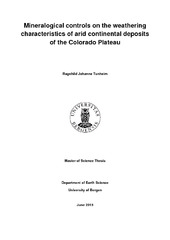| dc.description.abstract | The Permian to Jurassic stratigraphy of the Colorado Plateau includes a number of units that were deposited under arid depositional conditions. These units each show distinctive weathering characteristics which cannot solely be attributed to variation in depositional environment or burial history. The stratigraphic units are the Permian Cutler Formation, the Triassic Chinle Formation, the Jurassic Wingate Sandstone, the Kayenta Formation, the Navajo Sandstone, the Slickrock Member and the Moab Member. The objective of this study is to document and explain the differences in weathering pattern observed in these units. Typical slope angles were recorded to quantify weathering profiles. The Moab Member, the Kayenta Formation and the Wingate Sandstone have steep weathering slopes ranging from 70-90°. The main weathering processes are physical weathering leading to the formation of vertical joints and eventually splitting of the rocks. The Slickrock Member, the Navajo Sandstone and the Cutler Formation have lower weathering slopes ranging from 30-55°. These weathering profiles are most likely shaped by both physical and chemical weathering processes, through the process of spheroidal weathering. The weathering profile of the Chinle Formation is characterized by scree and the typical weathering slope is around 30°. The differences in weathering profiles are due to several factors. The first order control is the proportion of sandstone vs mudstone in the stratigraphic units. Sandstone and mudstone act very differently to stress. Sandstone responds in a more brittle way to stress than mudstones and consequently more mud rich units, such as the Chinle Formation, tend to be associated with scree slopes. The second order control is the dominant cement type in the stratigraphic units. Stratigraphic units with low and rounded weathering slopes are dominated by carbonate cement, while the steeper intervals are dominated by quartz cement. Carbonates are more easily dissolved when subject to chemical weathering and units with abundant carbonate cement will produce spheroidal outcrops. The weathering pattern can aslo be affected by external processes on a large scale, such processes can be river erosion or removal of underlying rock units. These processes can explain lateral differences in sandstones weathering patterns over short distances. | en_US |
